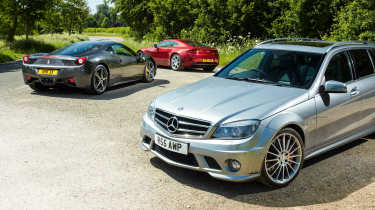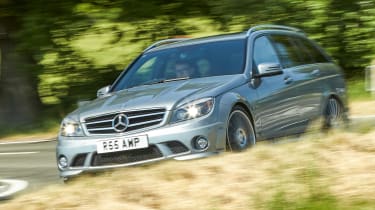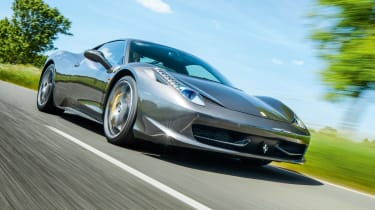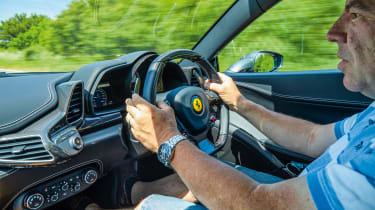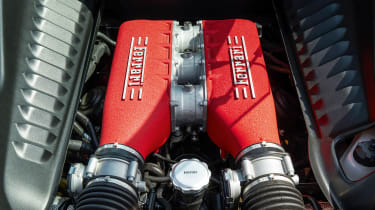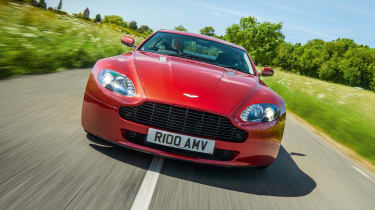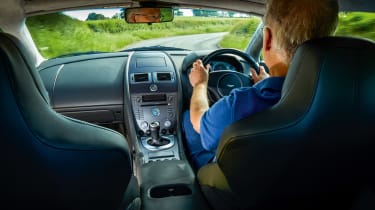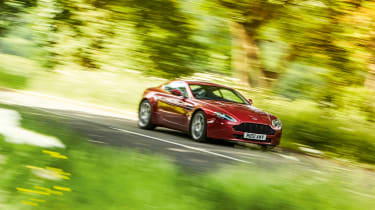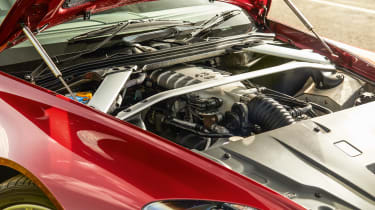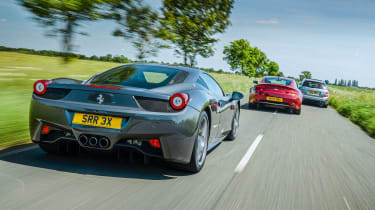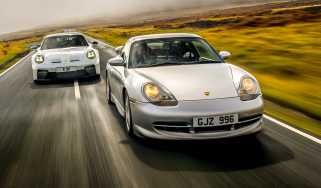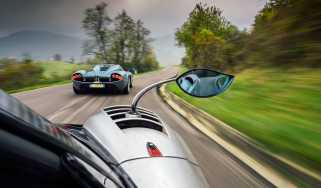Why now is the time to buy your dream used car
We speak with three people who believe now is the time to buy the car you always promised yourself, and enjoy it while you can
It’s hard not to be a touch gloomy about the prospects for the kind of cars and the sort of driving that people like us have always enjoyed. The days of internal combustion are numbered; electric power is the future; downsizing, turbocharging and hybridisation have already changed the very nature of modern performance cars, while multiplying layers of electronics leave us ever further removed from the simpler thrills of driving.
At some point in the not-so-distant future, performance might well be capped, road speeds limited by GPS, and road positioning determined by radar. If big tech gets its way, cars will eventually be self-driving. And, in the shorter term, as politicians look to persuade us out of our ICE machines and into air-conditioned battery-packs, expect hikes in excise duty and fuel taxes to nudge us in the right direction (and add much-needed loot to government coffers).
But there is another way of looking at all of this. Now might just be the time to go out and buy the used car you always promised yourself. That’s what these three chaps did – and their stories might just inspire you to do the same.
Mercedes-Benz C63 AMG Estate
evo’s Sam Jenkins is just 22 years old and remarkably this 6.2-litre 480bhp super-estate is the first car he’s actually owned
This car goes back to the very roots of my automotive obsession. Of course, mid-engined exotics were always hard to ignore, but the W204 Mercedes-Benz C63 AMG was where my passion for cars truly began. Its arch rival, BMW’s E92 M3, was similarly appealing to the pre-teenage me, but the combination of the AMG’s thunderous soundtrack and the fact that it was related to the SLS supercar fired my imagination like nothing else.
The W204 took the hot saloon/wagon formula to the next level, its gargantuan powerplant significantly more potent than that of any of its rivals – for some perspective, with the Performance Pack Plus (PPP) option, the 480bhp produced by its 6.2-litre V8 is more than even today’s G80 M3.
Granted, it lacks some of the dynamic ability of its Munich rival and suffers from Mercedes’ lacklustre interior design of the time. Its modern-day counterpart is undoubtedly capable, too, but as the other two cars in this feature suggest, it’s rather hard to resist the pull of a naturally aspirated V8.
Thanks to an incredibly fortunate set of circumstances, I was able to scratch my decade-long itch with the purchase of a C63 Estate. Though I had been set on a facelift car, the combination of a low 45,000-mile odometer reading, those glorious silver 19-inch multi-spoke wheels and the desirable PPP option meant I just couldn’t let this Palladium silver 2010 example go.
The facelift interior is much more modern and the switch from a seven-speed torque converter to a sharper MCT also plays to the advantage of more recent cars. That said, the C63’s highly addictive downshift barks are most definitely still present, while manual upshifts are more than brisk enough. The exterior design is significantly more aggressive on pre-facelift cars, too, and the bumper design has also proven to be more effective at providing cool air for the V8 – the more restrictive facelift bumper has caused some owners temperature issues.
Just shy of £23,000 is what I paid, but the £50,753 list price makes scary repair bills a real possibility. Noisy lifters and rattly camshaft adjusters are some of the most common issues, with head bolt failure also experienced in early cars. Fortunately my late pre-facelift example received revised items from the factory and has run without any major problems so far. Though a non-issue to some, the ability to play music through anything other than the radio is currently unavailable – even endless forum searches have offered no solution. In exchange for a healthy quantity of fuel, though, the throttle pedal offers plenty of auditory stimulation…
But why on earth – and how on earth, you may be wondering – did I purchase a C63 as what is technically my very first car (yes, really). Covid-induced working from home and a move back to the family abode eliminated the cost of living in London, and with little to spend money on during lockdown I was able to scrape together the funds. I did spend months pondering whether it would be more appropriate to use this sum for something a little more sensible. Any 22-year-old of sound mind would jump at the opportunity to get on the housing ladder, and rightfully so, but that can be done at any time… The ability to run a 6.2-litre V8 estate emitting the same amount of carbon as a LaFerrari probably has numbered days.
The other question I’m always asked is how I manage to insure it. Perhaps I’m odd, but even in my teens I spent hours on comparison websites in the hope of one day finding a reasonable quote for my dream car. For quite some time the figures exceeded the value of the car, before dropping to a few thousand once I reached my 20s. It wasn’t until I turned 22 and received a mind-boggling reasonable quote of just over £700 that I realised a C63 was within reach.
As for running costs, access to a steady stream of test cars allows me to use it purely as a weekend car, keeping mileage and fuel bills to a minimum. Predictably, though, resisting the urge to drive it daily during the first month of ownership proved harder than I’d imagined. I can’t deny that the C63’s value plays its part, too. Though it’s impossible to predict future values, prices do appear to be trending upwards, perhaps due to the rarity of what it represents. BMW dropped its glorious, naturally aspirated S65 V8 with the launch of the F80 M3 in 2014, with Audi and Mercedes following suit in 2015 – Germany hasn’t offered a single road-going NA V8 in over half a decade.
Of course, other super-estates are available, but the W204 C63 has something very special up its sleeve. The M156 V8. Unlike its Mercedes-built predecessor, the M113K, the M156 was the first V8 built from the ground up by AMG. Despite its 6208cc displacement, the 63 name pays homage to Mercedes’ very first production V8, the 6.3-litre M100. AMG opted for a naturally aspirated set-up, ditching the supercharger of the M113K to create one of the world’s most powerful NA V8s at the time of the C63’s launch.
Lift the double-ridged bonnet to its unique vertical position and you’ll find a rather attractive engine bay, itself a rarity today. What made this particular car so desirable to me was its darkened intake manifold, representing the use of the forged pistons from the SLS’s M159 unit, new connecting rods and a lightweight crankshaft, all courtesy of the aforementioned PPP option. Combined with an ECU tweak, these changes liberated an additional 30bhp for a total of 480bhp at 6800rpm.
Peak torque of 443lb ft comes at a refreshingly high 5000rpm too, encouraging frequent climbs to the 7200rpm red line. With a slight increase in weight, 0-62mph comes a tenth later in the estate than the saloon at 4.5sec, with top speed lifted to 174mph through the PPP option.
> New Mercedes-AMG C63 S E Performance revealed with 670bhp hybrid powertrain
A helping of Alcantara on the steering wheel also comes as part of the package, while red calipers signify the use of an uprated 360mm, six-piston front brake set-up with aluminium hubs designed to improve heat management. Though less impressive than some of today’s mammoth brake packages, the C63’s large drilled and slotted discs have drawn more comments than just about anything.
So good is the M156 that Mercedes-AMG still uses a derivative of it more than a decade after its launch, swapping the road-going AMG GT’s 4-litre twin-turbocharged eight for the naturally aspirated, dry-sump M159 in its GT3 racers. With a 2-litre four-cylinder C63 looming on the horizon, the M156 might just go down as one of the finest road car engines ever produced. Well, in my mind at least.
Purchasing a near-500bhp rear-drive AMG as my first car could be considered ludicrous. Running costs and the potential for a surprise bill are a scary thought, but the potential for missing the window to own my dream car was far scarier.
Mercedes-Benz C63 AMG Estate (PPP)
| Engine | V8, 6208cc |
| Power | 480bhp @ 6800rpm |
| Torque | 443lb ft @ 5000rpm |
| Weight | 1780kg |
| Power-to-weight | 270bhp/ton |
| 0-62mph | 4.5sec |
| Top speed | 174mph (limited) |
| Basic price new | £50,753 |
| Values today | £15,000-£25,000 |
Ferrari 458 Italia
Steve Rockingham has owned some iconic road and rally cars, but never a genuine slice of mid-engined exotica – until now
I’m a lucky fella, I realise that. Even before I picked up the Ferrari at the end of the spring, I’d owned a string of great road cars and some truly iconic rally cars, too. I didn’t have many car-related itches left unscratched, but there was one. I’d never owned a truly exotic mid-engined Italian supercar.
I wasn’t convinced I needed one in my life – until Adam Towler, an old mate who often gives me a steer on what to add to my stable, came on the phone. He knew I was considering a 458, but sensed I was wavering. ‘Just do it!’ he said. ‘You won’t regret it.’ So, what’s the verdict two months later? Was he right?
I first caught the collecting bug when an ex-Stig Blomqvist Lotus Sunbeam came on the market and I managed to get it for a figure you could only dream about today: £17,000. That was my first works car. After that I bought an ex-works Triumph TR7 V8, which I still have to this day. And in a moment of madness I bought an ex-Colin McRae Ford Focus World Rally Car, which I used for a few events, but it’s a really difficult car to run: so complicated and so expensive – way out of proportion with the fun you were having. Never mind fuel at £4 a litre, how about £250 for an oil filter, or £12,000 for a clutch!
Next I bought an ex-McRae Impreza WRC, the 1998 Rally of Portugal winning car. I had so much fun with that. It’s a car anyone could drive and it actually makes you look like you know what you’re doing. I’ve also got an ex-Tommi Mäkinen Impreza – the car in which he drove his last rally – and a Group A Peugeot 309 GTI that Richard Burns did the ’91 RAC Rally in, I believe his first factory drive.
So I’ve managed to build up a nice little collection. And I still drive the rally cars, though more often in demos these days, including the rally stage at the Festival of Speed. They’re like a ticket to all the best events.
Road cars have included a Ford RS200, an M5 V10 Touring, which was just fantastic, and I’ve currently got a Gen 1 997 GT3 RS in orange – I wanted green but I couldn’t find one, but otherwise it’s just about perfect!
And then I started thinking about a Ferrari. I’ve never had a Ferrari before and it was just one of those boxes you really need to tick.
I’d noticed that 488 prices were coming down, while 458s were staying pretty much level, but the 458 just looked prettier to my eyes, and the naturally aspirated engine was important, too. The last naturally aspirated Ferrari V8 had to be the one to have.
I think it might become a bit like the F355 – they were ‘the one to have’ for years. I haven’t bought it as an investment, but if it doesn’t lose a lot, that would be great. In the end, though, I just really fancied one!
So I trawled through all the ads, as you do, and looked at a couple of cars at main dealers, but they didn’t have quite the right spec. I wasn’t hung up about having a red one, or a Spider, but it did have to be the right colour/trim combination – I wanted a dark interior – and the right options.
Then a couple of months ago I spotted this 2015 car at Tom Hartley’s and I loved how it looked in Canna di Fucile (‘gunmetal’ in English, and apparently an old Ferrari racing colour) while the spec was awesome: front axle lift, carbon driver’s pack, which includes the LEDs on the steering wheel, full leather, carbon splitters and back panel, shields, sports exhaust, just about everything you could want. And just 7800 miles and one owner. It would have been a £230,000 car new; I paid £160,000 for it, which included a warranty, and it’s still under the Ferrari service plan, which runs for seven years, so it’s got at least another service in there.
I did toy with the idea of a McLaren, but I heard a few stories about things going wrong with them. And as soon as I drove the Ferrari I just fell in love with it. There’s something lovely about that naturally aspirated engine. The way it revs, it’s just fantastic. And the noise! It’s almost worth it for that alone.
I’m 58 now, and I’ve decided it’s all very well working yourself into the ground, but life is for living. I’m lucky enough to be fit and active – touch wood – but I know it won’t always be so easy for me to jump in and out of cars like these, so I’m making the most of it while I can.
The Ferrari won’t do a huge mileage – special days out, events, maybe the odd road trip. But it will be used and enjoyed – sometimes just going out and having a drive for the sheer hell of it. Somehow I can’t imagine doing that in a Tesla.
Ferrari 458 Italia
| Engine | V8, 4497cc |
| Power | 562bhp @ 9000rpm |
| Torque | 398lb ft @ 6000rpm |
| Weight | 1485kg |
| Power-to-weight | 384bhp/ton |
| 0-62mph | 3.4sec |
| Top speed | 202mph |
| Basic price new | £169,545 |
| Values today | £110,000-£160,000 |
Aston Martin V8 Vantage
A big birthday was just the excuse Peter Tomalin needed to buy the car he’d always promised himself
It doesn’t have to take something momentous to prompt you into buying the car of your dreams. But, in my case, it did. Within the space of roughly 12 months I’d lost both my parents and was about to turn 60. Which are the kind of events that make a chap reflect on life and re-order his priorities. And, after due reflection, pretty near the top of mine was buying an Aston Martin. What had been a daydream now felt like an imperative.
My dad had almost bought an Aston once, a DB6, back in the early ’80s, but it slipped through his fingers – and then values went through the roof. He’d missed his chance. I decided to take the plunge and, if things didn’t work out, at least I could bore my grandchildren by telling them how I once blew the family fortune on an Aston Martin. A far bigger regret would be looking back in five or ten years’ time and wishing I’d done it when I could. So, with a modest but very welcome inheritance, I started looking.
I’d decided it would be an early Gaydon-era car, either a DB9 or a V8 Vantage. A DB7 V12 Vantage would have been another option, but the more modern underpinnings of the ‘VH’ cars swung it for me. Both DB9 and V8V are pretty much at the bottom of their depreciation curves (or at least that’s what I’d convinced myself), with well cared-for examples widely available between £30,000 and £35,000.
You don’t have to pay even that much. You can find plenty of either, but Vantages especially, for less than £30k, usually either private sales or through non-specialist dealers. Many of these are good, well-maintained cars, but equally many will have been run on a limited budget with less than fastidious attention to servicing. Which gives significant potential for financial ruination. So if you’re looking at cars in the £25k-30k bracket, make sure you do your homework – there’s plenty of good advice out there on various forums and on YouTube from the likes of Aston indie Bamford Rose. If you don’t feel confident assessing a car yourself, many specialists provide an inspection service for a few hundred pounds that should flag up any looming issues, though there are, of course, no guarantees.
Except, that is, when you take the second option: pay a few thousand more and buy from either an official Aston dealer or a well-regarded specialist, knowing that the car will have been thoroughly checked and will carry a warranty for at least the first year. Being an Aston virgin and something of a coward, I knew this was the right course for me.
Next step was to drive examples of both. The DB9 is a fine GT and an undeniably beautiful car; it has a more spacious, more sumptuous interior, and – its trump card – it has that wonderful 5.9-litre V12 engine. The V8V is more than decently quick, even the early 4.3, but the big twelve is on another level: utterly effortless performance with a soundtrack that’s positively symphonic.
The Vantage is slightly more sporting in its dynamic make-up; its shorter body overhangs, slightly firmer suspension and – not least – the fact that its engine is set lower and further back in the chassis, mean it feels that bit more sucked down to the road, that bit more agile through a sequence of bends. The V8 isn’t as torquey as the V12, but its boisterously vocal soundtrack encourages you to rev it right out. A modern turbocharged sports car would blow it away, but it means you can enjoy the full reach of the VH V8’s performance all the way through the lower gears without waving your licence goodbye.
And that was the other thing in the Vantage’s favour: all early V8Vs are manuals when the vast majority of DB9s are autos with paddles: manual Nines are like hen’s teeth and command a substantial premium today. And I really liked the idea of a manual gearbox. While the shift in the Vantage isn’t the best – blame the remote linkage to the rear-mounted ’box – it does give you another tangible connection to the car, and its heavy, mechanical feel is evocatively redolent of Astons of the past. As a long-time Aston fan, I like that.
I was being drawn inexorably towards a Vantage, and then I spotted a new arrival amongst the stock of Warwickshire-based specialists McGurk Performance Cars: an early 2006 car in rare Toro red with Phantom grey leather, 40,000 miles, five former keepers (the only minus point) but well known to John McGurk and his team, since they’d serviced it for the last six or seven years and sold it twice before.
Knowing it probably wouldn’t stick around for long, I drove across to the showroom a couple of days later. And it did look absolutely terrific. The nose and the leading edge of the rear arches had a light freckling of gravel chips, but nothing serious; the door edges, handles and around the mirror supports (usually the first areas to suffer corrosion) all looked bubble-free; the clutch felt fine; there was no sign of oil leaks from the timing cover, and John assured me the rear subframe had only the usual superficial rust (gasket replacement, clutch renewal and subframe refurbishment being the biggest potential drains on your savings with these cars). Boasting a full service history, it had clearly been cherished by each of those previous owners.
The asking price was £32,850, so with the kind of brutal haggling that Alan Partridge would have been proud of, I hammered John McGurk all the way down to £32,500. He didn’t stand a chance. But a service and fresh MOT would be included and John offered to refurb a wheel that had a slight nerf to the rim. I was happy with that.
I picked it up the day before my big birthday. It was a gloriously sunny spring day and the drive home to Cambridgeshire was one of the highlights of my motoring life. That was three months ago and there hasn’t been a single moment of regret since.
According to John McGurk, values of early Vantages (and DB9s) had been gradually drifting downwards for a number of years, but from early 2020 they started to harden again and the best cars have even edged up by a few per cent over the last 12-18 months.
That’s a nice thought. But, honestly, it hardly crept into my reckoning. Because there are some things you just can’t value in pounds sterling. When I open the curtains in the morning and see the V8 Vantage sitting on the drive, it puts a soppy smile on my face; when I fire up the rowdy V8, I break out into a broad grin, and every drive genuinely does feel like an event.
My parents would have understood. ‘You are,’ as my mother often told me, ‘a long time dead.’ And, as my father often said, with slightly less profundity but no less feeling: ‘I should have bought that bloody Aston Martin.’
Aston Martin V8 Vantage
| Engine | V8, 4281cc |
| Power | 380bhp @ 7000rpm |
| Torque | 302lb ft @ 5000rpm |
| Weight | 1570kg |
| Power-to-weight | 244bhp/ton |
| 0-62mph | 4.8sec |
| Top speed | 175mph |
| Basic price new | £79,995 |
| Values today | £25,000-£35,000 |
Conclusion
It’s surely no coincidence that all three of the cars featured here are naturally aspirated; slightly more of a coincidence that they’re all V8s, but actually that’s not so surprising. Each of those engines is, as you’d expect, very different in nature to the next, from the C63’s thumping, torque-rich 6.3 to the 458’s screaming flat-plane-crank 4.5, but what they have in common – beyond their abundant power and keen throttle response – is a wealth of what we call character. Soul, if you like. These engines are living, (fire) breathing entities, the absolute heart of each of these cars. One thing’s for sure: you won’t get any of that from a battery pack.
Of course, other engine configurations are available. Yowling in-line fours, howling sixes (straight, bent and flat), even 10- and 12-cylinder cars are all out there waiting for you. We’ve focused here on three particular models, but we’ve barely scratched the surface of what’s available in today’s marketplace. E46 M3s and E39 M5s, 996 and 997-gen Porsche 911s, Audi R8s and B7-gen RS4s, Imprezas and Evos, Elises, Exiges and Esprits, RS Clios and Méganes, F430s and Gallardos – there really is something for all tastes and all pockets.
In time, cars like these will become a dwindling resource; restrictions on their use may well follow. But the underlying message here is a positive one. Their days may ultimately be numbered, but they’re still going to be around to enjoy for many years to come; these and literally dozens of other great cars that pulse with red-blooded vitality.
As long as you’re prepared to be realistic about the running costs, and unless you’re planning to drive them into the centre of London (and why in God’s name would you?) there really aren’t any prohibitive penalties for their use. For the time being, at least.
Which leaves only two questions. What are you going to buy – and what are you waiting for?
This story was first feature in evo issue 288.
